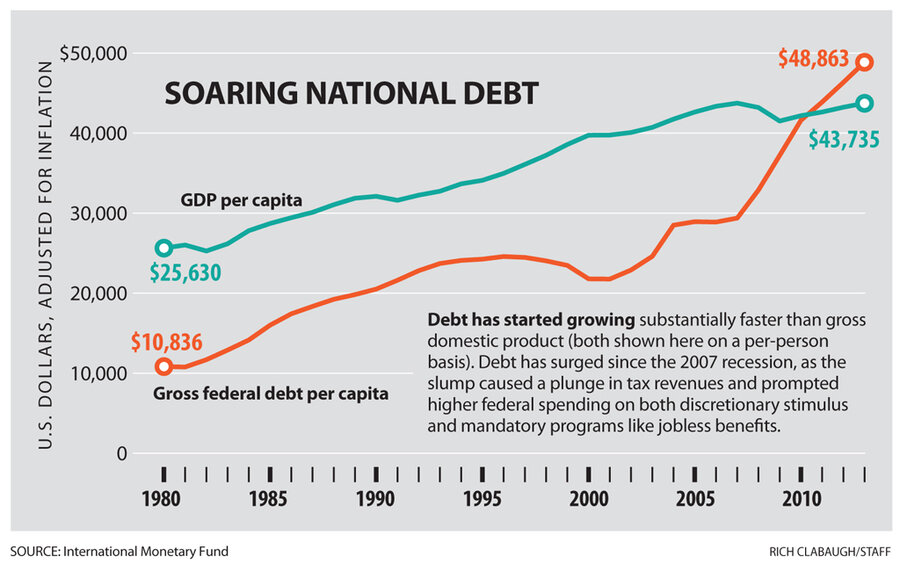Obama or Romney: Whose debt reduction plan does history favor?
Loading...
When President Obama and Republican challenger Mitt Romney make their pitch to voters on how they'd tame the nation's debt and grow the economy, each suggests history is on his side.
It's partly campaign rhetoric, but it represents a substantive point: The way forward for the US economy will be smoother if the nation takes appropriate cues from the experiences of other countries – and from its own past.
What are those lessons? The candidates have eagerly shared a few.
Mr. Obama notes that he arrived in office with the nation already in "the middle of the worst economic crisis since the Great Depression," a kind of contextual asterisk reminding voters to have patience on the road to recovery.
He also tells voters that a Romney presidency would return America to a failed Bush-era vision "that got us into this mess," a reference in part to policies that added to the federal debt while keeping taxes low for the rich.
And he refers to the policies of Abraham Lincoln, arguing that investments in education and infrastructure make government a contributor to economic growth, not an inhibitor.
Former Massachusetts Governor Romney says his tax reform would follow Ronald Reagan's 1986 approach, in which lower tax rates buoyed job growth, while limits on deductions helped ensure adequate federal revenue. And in the first presidential debate of the season, he pointed to the current financial crisis in Europe to make his case for big spending cuts.
"Spain spends 42 percent of their total economy on government. We're now spending 42 percent of our economy on government. I don't want to go down the path to Spain," he said.
So what are the most salient lessons history teaches about emerging from a deep slump – one attended by banking woes and rising debt? This story will highlight three broad lessons.
First, some general points to set the scene:
• Although America's economic path has been rough over the past four years, the United States isn't doing badly compared with other instances when recession has been accompanied by troubles in the financial system. Charts comparing various "financial recessions" at home and abroad suggest the recent US course is typical. This still leaves room for interpretation when it comes to Obama's track record. Some can say that he missed opportunities to kindle a faster recovery, others that the economy has done better on his watch than he's been given credit for. In fact, both points may be true.
• When it comes to the way forward, Obama and Romney have similarities as well as differences. Although Romney calls for a cap on government spending at 20 percent of gross domestic product and Obama does not, both candidates have voiced support for reducing federal deficits. That hints at another similarity: Neither is calling for the kind of stimulative fiscal policy next year that many economists recommend.
• Forecasters generally expect things to get better over the next four years – and for federal deficits to fall – no matter who is elected. The job market is improving, and US households have made substantial progress in "deleveraging" after heavy borrowing during the housing boom, both of which should buoy the economy's consumer sector. A big caveat: Europe's debt crisis and America's "fiscal cliff" (expiring tax cuts and new curbs on spending) cloud the outlook.
• Economists differ on whether America's high-level national debt is already crimping economic growth. But there's broad consensus that the long-term problem is real and that charting a fiscal course correction soon will make the problem easier to solve.
History lesson No. 1: Whatever else you do, grow!
Paying down debt is a lot easier if you have income. Faster growth creates not just jobs but also the right climate for easing fiscal challenges. Countries don't even need to achieve an outright reduction of debt. Often the key is just to have debt grow slower than GDP.
Sweden in the 1990s is a case study in how this can work. In the wake of a severe banking crisis and real estate collapse, the Scandinavian nation needed both jobs and debt control. It had a host of problems, from high taxes to heavily regulated markets.
In a chain of pro-growth reforms, Sweden made its labor market more flexible, lowered tax rates (boosting incentives to work and invest), and deregulated large swaths of the economy. The changes scaled back the welfare state but were done the Swedish way, retaining a large government and relatively small income disparities.
"A lot of people were saying, 'Yeah, it's not a dynamic society, but it's an equal society.' Well, today it is both equal and dynamic," Sweden's finance minister, Anders Borg, told a gathering at Washington's Peterson Institute for International Economics in April.
The point isn't that America should pattern itself on Sweden in all respects. Rather, Sweden's story shows the benefits when a nation pursues growth, not just stimulus or austerity.
Sweden's debt today is a relatively affordable 36 percent of one year's GDP, whereas in 1993 it totaled almost twice that. While the country's total government debt today is higher, measured in kronor, than it was in 1993, the economy's expansion made the difference in the debt-to-GDP ratio.
What Lesson No. 1 means now
Obama and Romney talk plenty about the need for vibrant growth and job creation, but their proposals draw mixed reviews from economists. Growth-oriented policies can include everything from streamlining the tax code to cultivating scientific innovation.
Not all the ground can be covered in this story, but here are some important contrasts.
Romney's mode of nurturing growth emphasizes low corporate taxes and easing the regulatory climate, while Obama's emphasizes the positive role government can play as an investor in scientific research, education, and other projects (one of them being a network of institutes to promote manufacturing innovation).
Economist Robert Atkinson, who specializes in innovation policy, argues that economic success depends on pursuing both those paths, not just one or the other.
Critics of the president, including some economists who aren't Romney supporters, say Obama has missed job-creating opportunities – for instance, that he could have pushed harder for corporate tax reform or pursued more domestic energy production.
Romney pledges to promote free trade while cracking down on trade-rule violations by China. Some economists welcome that stance, arguing that naming China a currency "manipulator" would help set the stage for a US manufacturing revival. Others caution that a more confrontational approach on trade could backfire, causing a 1930s-style retreat from global trade that damages growth in the US and abroad.
Lesson No. 2: Austerity or stimulus – a tricky choice
Some economists affiliated with the Romney campaign have argued that "fiscal consolidation" – essentially cutting spending to reduce deficits and the overall size of government – can help promote economic recovery.
But last year, when Italian economist Roberto Perotti looked for historical evidence, he found that four leading examples – countries that had combined austerity and recovery – didn't demonstrate clearly that spending cuts would spur growth in the US today.
Finland was a case in point. In the early '90s it suffered the worst recession of any advanced nation, and by the end of 1992 it "was widely considered the basket case of Europe," Mr. Perotti writes in his study, published late last year. The nation's economic output had fallen 14 percent, and government debt was soaring.
To get its house in order, the government pursued a mix that included tax hikes as well as spending cuts, Perotti found. The economy recovered, though slowly. The public debt was stabilized. But Perotti concludes that this success story hinged on an export boom and on declining interest rates.
Today, the US already has ultralow interest rates and would find it hard to follow the Finnish model on trade, which included a major currency devaluation. Such a move is difficult, since other nations want to keep their own currencies weak to promote exports.
What about the opposite approach: stimulus? Most economists embraced the idea of a large stimulus package in 2009, as the nation reeled in recession. Even today, the government could pump more money into the economy through various spending efforts and tax cuts.
Some prominent economists back this approach, noting that US economic output is still running about 4 percent below its potential.
"It's not that complicated," argues Jared Bernstein, a former Obama administration economic adviser. "When the private sector is still climbing off the mat, [there's a] role for government to temporarily fill the gap."
But the lessons of history on stimulus aren't clear-cut, either. On the positive side, an assessment released this month by International Monetary Fund (IMF) economists concluded that the "multiplier" benefits of stimulus programs appear to be larger than usual since the 2008 recession, given "today's environment of substantial economic slack."
The IMF also warns that if too many nations tighten their fiscal belts all at once, it would damage global growth.
"Everyone agrees that imposing fiscal austerity in a very short period of time depresses the economy and makes it even harder to grow out of the debt problem," says Ed Yardeni, an economist who runs an investment advisory firm in Great Neck, N.Y.
At the same time, he and others point to Japan as an example of a nation that has tried fiscal stimulus in recent years without generating strong growth. Its national debt has soared to world-leading proportions, raising the risk of a financial crisis there.
What Lesson No. 2 means now
Obama and Romney aren't campaigning overtly as apostles of either stimulus or austerity. But the goal of shrinking government is one of five core planks in Romney's economic plan. Obama, by contrast, has proposed an American Jobs Act that blends temporary tax cuts with spending on things like preventing teacher layoffs and building roads. Judging by such evidence, Romney leans more toward austerity and Obama more toward stimulus.
In practice, however, it appears US fiscal policy is headed in the austerity direction, whoever occupies the White House.
Both Romney and Obama embrace the long-term goal of deficit reduction. Economists estimate that the US is already experiencing some "fiscal drag" on growth, as various stimulus efforts expire. For much of next year, the stance of fiscal policy could shave 1.5 percentage points off the pace of economic growth, due to tax hikes in Obama's health-care reforms and the likely expiration of temporary payroll-tax breaks, analysts at the investment firm Goldman Sachs estimate. The drag would become much worse if Congress fails to address the fiscal cliff.
Lesson No. 3: Heal the financial system
The banking industry and federal policy on money supply aren't popular topics on the campaign trail, but they are big ones for economists who study how nations get in and out of trouble.
Exhibit A here is the Great Depression of the 1930s. Tight monetary policy was a major cause of the Depression, researchers generally say. And in 1937, a rebound turned into a deep second dive for the economy, again with tight monetary conditions as a cause.
The lesson of 1937 appears simple. When your economy is weak, don't have the central bank take actions that make it harder for credit to flow. An addendum for today: If a debt burden is part of the challenge, with pressure to fix government deficits, then loose monetary policy can be a vital cushion against recession.
In a related lesson of history, when a central bank is trying to fuel a revival by opening the money spigot, private-sector banks are important as conduits of new credit. Many analysts attribute Japan's doldrums in the 1990s partly to "zombie banks" that were allowed to keep bad loans on their books, rather than acknowledging losses and restructuring.
What Lesson No. 3 means now
Obama and Romney differ on policy toward banking and the Federal Reserve, although Romney hasn't defined his positions very thoroughly. Obama reappointed Ben Bernanke, the architect of unconventional efforts as Fed chairman to loosen monetary policy further once short-term interest rates had already fallen to zero percent. The Romney campaign has criticized the Fed's most recent round of Bernanke-led bond purchases, or "quantitative easing," as ineffective.
Romney has said he would not reappoint Mr. Bernanke in 2014, and has voiced support for "monetary stability" – a suggestion that the Fed has been too loose, and a signal Romney views other steps (not monetary policy) as keys to strengthening the recovery.
On banking, Obama's signature policy is the Dodd-Frank financial reform act, which among other things calls on big banks to hold more capital, and will limit their ability to do risky trading alongside traditional lending.
Romney calls for repealing Dodd-Frank, calling it regulatory encroachment on the private sector.
Many mainstream economists say banking reforms were necessary after the financial crisis. Some, while endorsing elements of Dodd-Frank, agree with the Romney view on parts of the law. Others say the law doesn't go far enough toward ending the problem of bailouts when "too big to fail" banks get in trouble.
On monetary policy, many economists give a nod of approval to the Bernanke Fed. In a recent survey, about 60 percent of those who work as business forecasters said US monetary policy currently is "about right."








